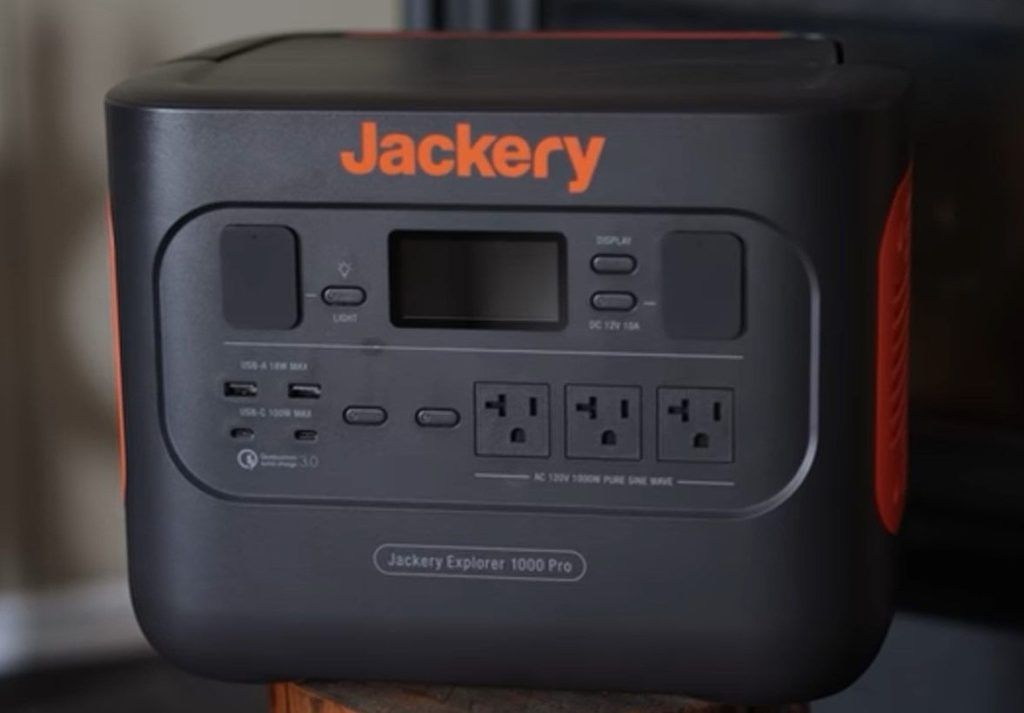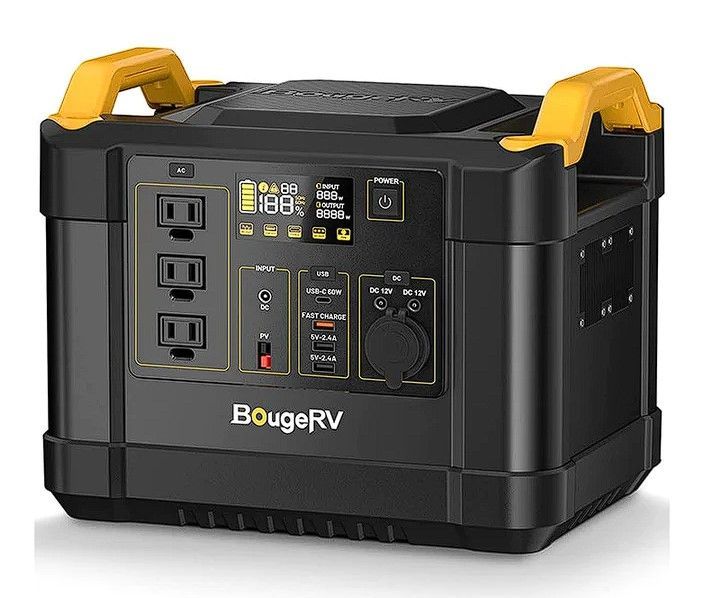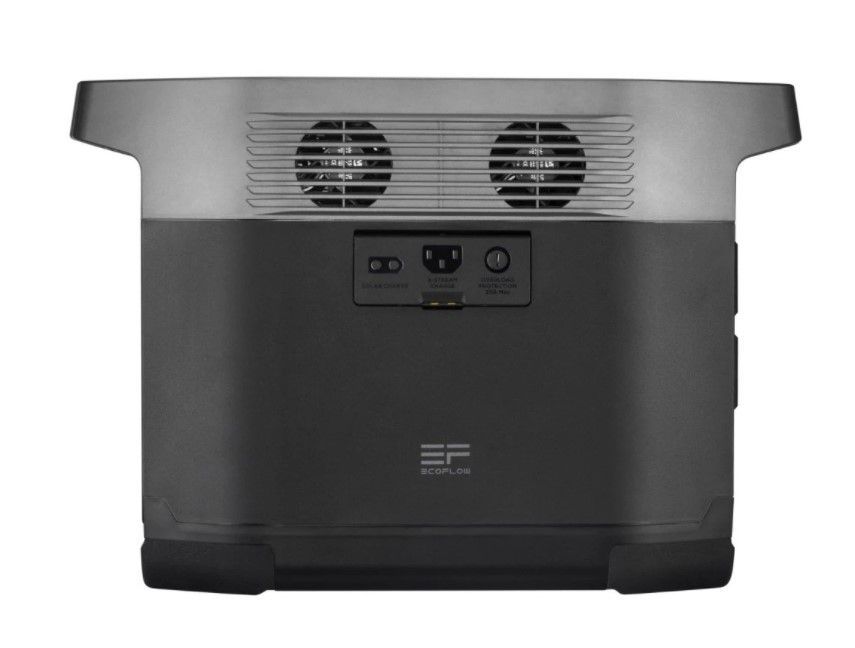Jackery Explorer 1000 Pro Review: Should You Upgrade?

The Jackery Explorer 1000 Pro has become one of Jackery’s flagship power stations. This portable power station features multiple improvements over its predecessor, the Explorer 1000. Aside from that, it boasts various features that are awesome for camping that its competitors fail to offer.
So, should you splurge on this portable power station? That’s what this comprehensive Jackery Explorer 1000 Pro review will help you decide. In the following paragraphs, I’ll tell you everything you need to decide whether this unit deserves your money or not.
But for those who want a short answer, here it is: if you have the original Explorer 1000, there’s no need to upgrade to the new one, unless you have the cash and just want a new look (I admint it looks much better). For those who are looking to buy a new power station, I would recommend going for the 1000 Pro. As even with a slight increase in weight, it’s revamped, has more lifecycles, charges much quicker, and quite likely the older version will be soon discontinued anyway.
*The Wild Guides is reader-supported. When you buy through links on my site, I may earn an affiliate commission at no extra cost to you. Learn more*

The Summary
The Jackery Explorer 1000 Pro is definitely an upgrade of the classic Explorer 1000. The battery has more life cycles, charges much quicker (more than 3x quicker using AC or car adapters and 8x quicker with solar panels), has more ports and it can self-diagnose faults. The drawback of Jackery Explorer 1000 Pro is that it weighs and costs more than the Explorer 1000.

Jackery Explorer 1000 Pro
Jackery Explorer 1000 Pro Review

Package Contents
- Jackery Explorer 1000 Pro
- Car Charging Cable
- AC Charging Cable
- DC7909 to DC8020 Adapter
- User Manual
Weight and Build
The Jackery Explorer 1000 Pro weighs 25.35lbs. This makes this model heavier than its predecessor, the Explorer 1000, which weighs in at just over 22lbs. Its high weight is the reason why, despite its foldable handle, I you might have difficulty carrying the Explorer 1000 Pro around your campsite.
A front-facing, backlit display adorns the center of this unit’s control panel. Jackery claims that the display can show information about 18 functioning modes. On the left side of the display is a flashlight with two brightness levels and an SOS function, making this model usable after dark.
Three on/off buttons for the SOS light, screen, and DC ports are neighboring the display. In the second row, starting from left to right, are multiple USB ports and 3x AC Ports. Both sets of ports have their separate on/off buttons. Like the DC ports, the AC ports are covered when not in use.
For products bought through Jackery.com, the company offers free shipping within the US, a 24-month warranty, free replacements and a 30-day money back guarantee.
Find out more here
Battery and Ports
The Explorer 1,000 Pro packs an ultra-powerful 1002Wh, Lithium-ion battery. Per Jackery’s estimates, the battery will retain at least 80% of its capacity for the first 1,000 life cycles. This is an upgrade over previous Jackery models, whose battery capacity was rated at 500 life cycles.
A Battery Management System (BMS) protects the Explorer 1000 Pro’s battery from over-charging, under-current, and over-current. Make sure to plug in only those devices whose power requirements are less than this model’s power output. Otherwise, the BMS will turn off this unit.
One area where the Explorer 1000 Pro really shines is its ports. This model comes with 3x AC ports, 2x USB-A (QC 3.0) ports, and 2x USB-C ports. In addition, it offers a 1x DC car port (12V, 10A). All these ports help this model charge up to 8 devices simultaneously.
As with previous Jackery power stations, all the AC ports supply pure sine wave current. You can thus rely on them to juice up sensitive electronic items, like smartphones, tablets, and laptops. That is something inverters with modified sine wave output cannot do.

Recharging Options
You have four options to recharge the Explorer 1000 Pro:
- AC adapter (1.8 Hours)
- 12V Car Adapter (4.37 hours)
- 4x SolarSaga 200W Solar Panel: 1.8 Hours
- 2x SolarSaga 80W Solar Panel: 9 Hours
Having tried all these recharging options, I now prefer my AC adapter to juice up the Explorer 1000 Pro. Not only is this charging method the most hassle-free (you just have to plug a piece of the power cable into your home’s mains) but it’s also very quick and efficient.

Jackery Explorer 1000 Pro
Other Notable Features
Here are other stand-out features of the Explorer 1000 Pro:
- Built-in MPPT charge controller. A built-in MPPT controller is the reason why this model takes little time to go from 0 to 100% charging. This device optimizes the Explorer Pro’s charging efficiency, helping it get back up from dead in virtually no time.
- Self-diagnoses faults. Here’s a neat little feature that I haven’t yet used, which is good as it means that my Explorer 1000 Pro has worked seamlessly since its purchase. However, I expect this feature to be an absolute lifesaver if/when things go south.
- Automatic shutdown feature. This feature ensures that the Explorer 1000 Pro automatically shuts down after running continuously for 12 hours. In doing that, it ensures that some battery power remains for the next charging session.
- Virtually noise-free operation. Even when it’s running at full speed, the Explorer 1000 would only produce about 45 dB of noise. This makes this model slightly louder than a whisper (30 dB) but quieter than a normal conversation (60 dB).
- Supports pass-through charging. If you’re like me, you’d hate waiting for the Explorer 1000 Pro to get back up to speed before it can power up your devices. Guess what? With pass-through charging, this unit can juice up devices while being recharged itself.
- Is drop-proof. If there’s one feature that alone makes the 1000 Pro a must-have for frequent travelers, it has to be its ability to survive multiple falls and not let those drops (from up to a certain height) affect its performance.
Pros and Cons

Pros and Cons
The Jackery Explorer 1000 Pro offers various excellent features. These include a built-in MPPT controller, the ability to self-diagnose faults, and support for pass-through charging. A virtually noise-free operation and automatic shutdown feature further distinguish this model from rivals.
However, just like any other electronic device, this model isn’t fault-proof. For instance, an integrated power supply has made this unit much heavier than its predecessor. Sure, that means you don’t have to carry around a power brick at all times to charge this unit. But the extra pounds are noticeable.
Let’s look at the pros and cons of Jackery Explorer 1000 Pro:
Jackery Explorer 1000 Pro Pros
- Self-diagnoses faults
- Built-in MPPT controller
- Virtually noise-free operation
- Automatic shutdown feature
Jackery Explorer 1000 Pro Cons
- Weighs a lot

Jackery Explorer 1000 Pro
Best Solar Panel for Jackery Explorer 1000 Pro

The Jackery SolarSaga 200W and SolarSaga 80W are the best solar panel for Explorer 1000 Pro. Jackery claims that four SolarSaga 200W solar panels can take this model from 0 to 100% in less than 2 hours. Two SolarSaga 80W can do the same in no less than 9 hours.
Before you take these estimates at face value, let me remind you that they are based on ideal conditions. By ideal conditions, I mean maximum sunlight with zero obstructions between the sun’s rays and SolarSaga solar panels, which is something that won’t always be possible.
On a positive note, the SolarSaga 200W and 80W solar panels feature their own USB-C outlets, AC ports, and USB-A outlets. As a result, after hooking up your Explorer 1000 Pro to either of these solar panels, you can charge your devices directly from the latter.
Jackery Explorer 1000 Pro Vs Explorer 1000
Since the Explorer 1000 Pro was released many years after the Explorer 1000, I was expecting the model to feature various improvements over its predecessor. Luckily for me, Jackery didn’t disappoint. Here are the major areas where the Explorer 1000 Pro fares better:
1) No need to carry a separate power brick
The Explorer 1000 Pro doesn’t require you to carry a separate power brick to recharge this device. That is because a power supply has been integrated into the unit. That isn’t the case with the Explorer 1000, which requires you to always carry a power brick.
2) Recharges much more quickly than the Explorer 1000
Here’s how much time the Explorer 1000 Pro takes to go from 0 to 100% charging:
- AC adapter – 1.8 Hours
- 12V Car Adapter – 4.37 hours
- 4x SolarSaga 200W Solar Panel – 1.8 Hours
Here’s the time Explorer 1000 takes:
- AC Adapter – 7 hours
- 12V car adapter – 14 hours
- Compatible Solar Panel – 16 hours under full sunlight
3) Battery is rated to last much longer
As noted in our detailed Explorer 1000 review, that power station’s battery is rated to last up to 500 lifecycles while maintaining a charging capacity of up to 80%. In contrast, with the Explorer 1000W, the battery is rated to last up to 1,000 lifecycles.
4) Explorer 1000 cannot self-diagnose faults
As stated above, the Explorer 1000 Pro can diagnose and display faults on its multi-inch screen. So, if anything ever went wrong, you won’t be left in the dark about what happened. The Explorer 1000 doesn’t come with this handy feature.
5) Explorer 1000 Pro is drop-proof
To be honest with you, I’m yet to put this claim to the test. But the fact that Jackery advertises this model’s ability to survive falls means there must be 100% truth in it. Thus, regardless of how you look at these power stations, the Explorer 1000 Pro is a clear upgrade over the Explorer 1000.
How Explorer 1000 Pro Compares with Other Portable Power Stations
Jackery Explorer 1000 Pro vs. Goal Zero Yeti 1000X

Goal Zero Yeti 1000X
- Power: 983 Wh
- Weight: 31.7 lbs.
- Dimensions: 15.25″ x 10.23″ x 9.86″
- Ratings: 4.2⭐ out of 27 reviews on REI
- Similarities: The Explorer 1000 Pro and Yeti 1000X pack batteries with similar capacities (1,002Wh vs. 983Wh). Both also feature the same number of USB-C (2) and USB-A ports (2). That’s where their similarities end.
- Where the Explorer 1000 Pro fares better: Despite costing $200 fewer than the Yeti 1000X, the Explorer 1000 Pro offers more AC ports (3 vs. 2) and weighs less (22lbs. vs 31.68lbs.) than its rival. Plus, it’s backed for an extra year (3 vs. 2).
- Where the Yeti 1000X fares better: Unlike the Goal Zero power station, the Yeti 1000X can be daisy-chained using Yeti Link and Tank Expansion batteries. Furthermore, its inverter boosts a higher surge capacity.
Jackery Explorer 1000 Pro vs. BougeRV Fort 1000

BougeRV Fort 1000
- Power: 1120 Wh
- Weight: 28.7 lbs.
- Dimensions: 12.6″ x 9″ x 11,4″
- Ratings: 4.9⭐ out of 27 reviews on BougeRV
SPECIAL DISCOUNT: $200 OFF WITH THE CODE TWG200
- Similarities: The Explorer 1000 Pro and BougeRV Fort 1000 offer similar numbers of AC and USB-A ports, and both have a built-in MPPT controller and use Pure Sine Wave technology.
- Where the Explorer 1000 Pro fares better: The Explorer has an additional USB-C port. It also weighs nearly 3 lbs. less making it one of the most lighweight power stations in the 1000 Wh power range. Jackery also offers a longer warranty (2 years vs 1 year).
- Where the BougeRV fort 1000 fares better: The Fort 1000 costs $100 less, and has a more powerful battery (1120 Wh vs 1002 Wh). It also outperforms the Explorer 1000 Pro and many other power stations in the number of Life Cycles at 80% capacity; the Fort 1000 states it offers 3500+ Cycles to 80% Capacity, while the Explorer 1000 Pro only promises 1000.
Jackery Explorer 1000 Vs. Rockpals 1000W

Rockpals 1000W
- Power: 1048 Wh
- Weight: 35.3 lbs.
- Dimensions: 15.55″ x 8.46″ x 9.44″
- Ratings: 3.9⭐ out of 28 reviews on Amazon
- Similarities: The Explorer Pro and Rockpals 1000W output the same continuous power, come with lithium-ion batteries, and feature two side vents each to prevent the likelihood of heat building up.
- Where the Explorer 1000 Pro fares better: The Explorer Pro an extra recharging option (carport), has a higher surge capacity (2,000W vs. 1,048W) and weighs less (25lbs vs. 35lbs.). Plus, its warranty is 1 year bigger.
- Where the Rockpals 1000W fares better: The Rockpals 1000W comes with more USB-A ports (8 vs. 2) and AC outlets (4 vs. 3). These are the only areas where this model can get the better of Jackery’s latest power station.
Jackery Explorer 1000 Vs. Ecoflow Delta 1000

EcoFlow Delta 1000
- Power: 1008 Wh
- Weight: 30.9 lbs.
- Dimensions: 15.7″ x 8.3″ x 10.6″
- Ratings: 4.8⭐ out of 227 reviews on Home Depot
- Similarities: The Explorer Pro 1000 and Ecoflow Delta 1000 come with similar-capacity Li-ion batteries, and 2x USB-C ports. Each of them can be recharged using compatible solar panels, a car adapter, or directly from the mains.
- Where the Explorer 1000 Pro fares better: The Explorer Pro 1000 is much more compact and weighs less than its counterpart. What’s more, unlike the Delta 1000, this model has an SOS light and can thus stay useful when it’s dark out there.
- Where the Ecoflow Delta 1000 fares better: The Ecoflow Delta 1000 costs $300 less than the Explorer 1000 Pro. Yet, it offers more AC outlets (6 vs. 3), USB-A ports (4 vs. 2), and a higher continuous power (1,800W vs. 1,000W).
Frequently Asked Questions
How long does Jackery 1000 Explorer Pro last?
The Jackery 1000’s battery is rated to last up to 1,000 cycles while retaining up to 80% of its charging capacity. Put another way, this model should last anywhere between 4 and 6 years, if not longer.
How many solar panels does it take to charge a Jackery 1000 Pro?
Jackery claims that four SolarSaga 200W solar panels will take less than 2 hours under full sun to take the Explorer 1000 Pro from 0 to 100 percent battery.
Can Jackery 1000 Pro run a heater?
Yes. The Explorer 1000 Pro can keep a 350W electric heater running for up to 2.5 hours.
Can Jackery 1000 Pro run a refrigerator?
Provided it’s fully charged, the Jackery 1000 Pro can keep a refrigerator (520W) running for up to 1.6 hours.
Can you run a CPAP machine on Explorer 1000 Pro?
The Explorer Pro can juice up a 10W CPAP machine up to 80 times in one full charge.

Jackery Explorer 1000 Pro
Check out the video review
Jackery Explorer Comparison Table
This table compares the main differences between Jackery Explorer Portable Power Stations
| Jackery Model | Capacity | Weight, lbs | Dimensions, in | AC Recharge time | Solar Recharge Time | Compatible Solar Panel |
|---|---|---|---|---|---|---|
| Explorer 160 | 167Wh | 3.97 | 7.4 x 4.5 x 6.7 | 5 Hours | 4.5 Hours | SolarSaga 60W |
| Explorer 240 | 240Wh | 6.6 | 9.05 x 5.24 x 7.87 | 5.5 Hours | 7 Hours | SolarSaga 60W |
| Explorer 300 | 293Wh | 7.1 | 9.1 x 5.2 x 7.8 | 4.5 Hours | 5 Hours | SolarSaga 100W |
| Explorer 500 | 518Wh | 13.32 | 11.8 x 7.6 x 9.2 | 7.5 Hours | 9.5 Hours | SolarSaga 100W |
| Explorer 1000 | 1002Wh | 22.04 | 13.1 x 9.2 x 11.1 | 7 Hours | 8 Hours | SolarSaga 100W |
| Explorer 1000 Pro | 1002Wh | 25.35 | 13.39 x 10.32 x 10.06 | 1.8 Hours | 1.8 Hours | SolarSaga 200W |
| Explorer 1500 Pro | 1512Wh | 37.4 | 15.1 x 10.6 x 12.1 | 2 Hours | 4 Hours | SolarSaga 100W |
| Explorer 2000 Pro | 2160Wh | 43 | 15.1 x 10.5 x 12.1 | 2 Hours | 4 Hours | SolarSaga 200W |
| Explorer 3000 Pro | 3024Wh | 63.93 | 18.6 x 14.1 x 14.7 | 2.4 Hours | 3-4 Hours | SolarSaga 200W |
Portable power station guides
Use this table to find out all the reviews I made about the best portable power stations in the industry.
